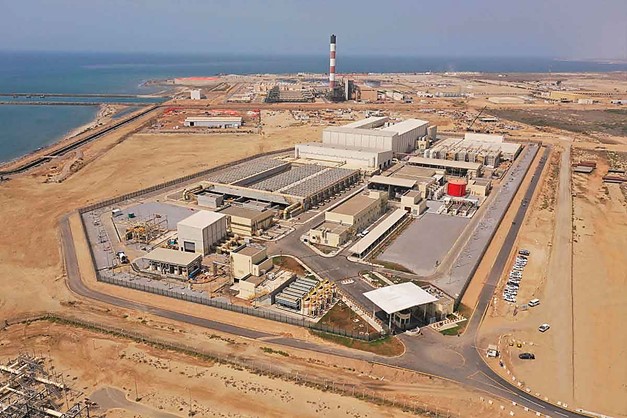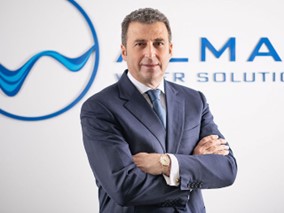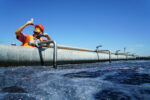Thirst for investment: solving the Middle East’s water challenges
The summer of 2021 was one of the hottest on record across the Middle East, with temperatures pushing 50 degrees Celsius in several places – almost seven degrees higher than usual for the summer months. All the signs are that this heat was not a one-off.
As the temperature rises, so natural water sources become scarcer, a problem which is exacerbated across the GCC states by a lack of resources and variable infrastructure. It is no exaggeration to say that water scarcity is now one of the biggest challenges facing the region’s people, economy and future.
Demand and supply – a widening gap
The statistics bear out the scale of the challenge.

UNICEF states that 11 out of the 17 most water-stressed countries in the world are in the Middle East and north Africa: Qatar, Israel, Lebanon, Iran, Jordan, Libya, Kuwait, Saudi Arabia, the United Arab Emirates, Bahrain and Oman[1].
In 2020, a report by Orient Planet Research[2] found that the GCC’s water needs will reach 33,733 cubic meters per year by 2050, but the region’s projected future storage is only 25,855 cubic meters. This report established that the region needed to boost its water by 77% to meet the requirements of its population within the next 30 years.

“There are more than 50 million inhabitants across the GCC today, and this number could increase by approximately 14 million by 2050. The water-intensive lifestyle prevalent in the Gulf countries, as well as their steady economic progress, are going to further widen the demand-supply gap in the future,” said Nidal Abou Zaki, managing director of Orient Planet Group.
Each country in the GCC must rise to this challenge.
Saudi Arabia is classified as one of the most water-scarce nations on the planet. The absolute water scarcity level is 500 cubic metres per capita, yet Saudi Arabia has only 89.5 cubic metres per capita, per year[3]. In the UAE, the water table has dropped by around one meter per year over the last 30 years and the country has been predicted by some to face running out of natural freshwater resources within 50 years[4].
Migration from rural to urban areas, population growth, poor water management, deteriorating infrastructure and issues with governance are all making a big problem worse. The GCC has one of the fastest-growing populations in the world, with most of the resulting effects felt in cities.[5] The member nations of the GCC have a combined population in 2022 of more than 54 million people. Saudi Arabia alone has a population of almost 36 million.[6]
Facing the consequences
Water shortages are already having vast social and commercial impacts across the GCC. The repercussions are greatest on children, with around nine out of 10 living in areas of high or extremely high water-stress countries[7].
According to the World Bank, water scarcity could cost some regions up to 6% of their GDP over the next 30 years.[8] It will also drive migration, increase food prices and is likely to increase the risk of conflict. Already, disagreements over water resources are a regular occurrence in the region, as many rivers and lakes are shared by two or more countries.

Sagatom Saha, an independent energy policy analyst, said: “Nearly every country in the Middle East from Morocco to Iran shares water resources with a neighbor, and some have little freshwater of their own.[9] More affordable desalination and less water-intensive agricultural practices can help divorce food and health outcomes from warming. Climate change will take place over decades, but policies adopted today will determine what role it will play in the Middle East. Policymakers need not leave it to fate.”
A heightened urgency
While water shortages are not a new phenomenon, experts across the world agree the problem has accelerated over the last decade, and will continue to do so.
Climate change will drive the problem over the next five, 10 years or more – Arab Climate Futures, a research paper released in 2021, projected average temperature increase for the Middle East will be 2.0 to 2.7 degrees Celsius between 2040 and 2059. In some areas, it may be up to 3.3 degrees hotter. [10]
In August 2021, a report by the UN Intergovernmental Panel for Climate Change projected that winters in the GCC will get drier and the summers wetter. Water gains, however, will be offset rapidly and irreversibly by waves of extreme heat.
According to Mansour Almazroui, director at the Center of Excellence for Climate Change Research at Saudi Arabia’s King Abdulaziz University: “The problem is, with this whole temperature rise, whatever rainfall will come will evaporate because it is so hot. This rain is not necessarily going to be usual rain. There’s going to be extreme rainfall, meaning floods like those happening in China, in Germany, in Belgium. These floods will be a big problem for the Middle East. This is really a big climate change issue.” [11]
In March 2022, the UNICEF echoed this concern: “Water scarcity is only going to get worse in this region,” said the organization’s regional climate change advisor, Chris Cormency.[12]
The response so far
With water demand already far outstripping supply across much of the region, the situation has clearly moved into a new, heightened state of urgency. The good news is governments across the GCC are responding swiftly – and decisively – to the climate emergency and rapid progress has been made over the last few years.
 In 2019, the Saudi Arabian government launched a national water program, Qatrah. Qatrah, part of the Ministry of Environment, Water and Agriculture, aims to cut water consumption by about 43% to 150 litres per capita, per day by 2030[13], by encouraging change in individual behavior by raising awareness of the issue. It also aims to reduce water consumption in the agricultural sector, which consumes the vast majority of water in Saudi Arabia.
In 2019, the Saudi Arabian government launched a national water program, Qatrah. Qatrah, part of the Ministry of Environment, Water and Agriculture, aims to cut water consumption by about 43% to 150 litres per capita, per day by 2030[13], by encouraging change in individual behavior by raising awareness of the issue. It also aims to reduce water consumption in the agricultural sector, which consumes the vast majority of water in Saudi Arabia.
Similarly, in 2008 Qatar launched its National Vision (QNV), aiming to balance economic development with human and natural resources. The QNV 2030 pledges to rationalize water consumption and encourage the use of non-conventional water resources.
In 2019, the UAE was named as one of more than a dozen countries facing extreme pressure on its resources with groundwater reserves depleted.[14] In response, its Water Security Strategy 2036 identified how the country aimed to reduce demand on water resources by 21%; increase the reuse of treated water to 95%; reduce average consumption by each person by half and develop a storage capacity for more than 45 days in extreme emergencies.[15]
Suhail Al Mazrouei, Minister of Energy and Infrastructure, said: “The strategy came out of necessity as we have limited rainfall in the UAE, and we had to look at our resources to ensure access to clean, adequate and affordable water for years to come. For us living in this arid environment, we have to work harder.”
Desal pays dividends
One of the main technologies that is helping GCC countries to work harder in addressing their water scarcity challenges is desalination – the process of extracting salts and other materials from seawater to create fresh water, which can be converted into ultrapure water for drinking or potable water for industry and agriculture.
Desalination already contributes more than 90% of daily water requirements across the Middle East. Investment in desalination continues to increase rapidly, with around 48% of the world’s desalination investments taking place in the Middle East and north Africa[16].

Desalination capacity by region

Shuqaiq 3 – tapping the oceans
Saudi Arabia is responsible for around one-fifth of global desalination production[17], generating around four million cubic metres of desalinated water per day, making it the largest desalination market in the world.[18]
As part of its Qatrah program, it aims to invest US$ 80 billion in new desalination projects over the next decade to boost its water supply yet further in the face of growing demand. Earlier this year, it announced 60 new desalination projects that will increase its desalination capacity to 7.5 million cubic metres of water per day by 2027, from 2.54 cubic metres per day in 2021 – nearly tripling the capacity in just six years.
One of those projects at the forefront of this investment drive is the Shuqaiq 3 desalination plant, in the country’s southwestern Jizan province on the shores of the Red Sea.
Awarded to a consortium of Almar Water Solutions (through Abdul Latif Jameel Enterprises), Acciona, Marubeni Corporation and Rawafid Alhadarah Holding Co, Shuqaiq 3 began commercial operations in January 2022. It is one of the largest Reverse Osmosis (RO) desalination plants in the world and a key project in the modernisation of the country’s water sector.
More than 2,000 people worked on its construction of Shuqaiq 3. The plant has more than 7,000 reverse osmosis pressure tubes which, when placed end-to-end, would measure almost 54km long. It has a nominal production capacity of 450,000 cubic metres per day, equivalent to 180 Olympic-size swimming pools, to help supply the water needs of 1.8 million people in the provinces of Asir and Jizan.
Ensuring the plant was as energy efficient as possible and minimizing its environmental impact were key considerations from the outset, as Technical Director Luis Morales explains:
“We adapted our designs to reduce energy consumption. We worked with membrane suppliers to adapt the membranes so they would function more efficiently in deep seawater, for example. We designed a system that uses high pressure pumps installed in a ‘frame’, rather than individually. This allows us to manage all the pumps at the same time, which significantly improves efficiency. We use a two-pass process for the water, whereby it passes through the membranes twice. By carefully analyzing the data, we can tweak this process to find the perfect distribution between the first and the second pass to improve efficiency even more.”
“In addition, we worked with our technical specialists to reduce the water pump pressure from 4.5 bars to 3.9. This may not seem like a lot, but in terms of the amount of water we produce, this small reduction in pressure results in very big gains in energy efficiency.”


Shuqaiq 3 has been recognized across the water sector as one of the most complex, innovative and sustainable plants in its class. In September 2019, the project was awarded the Utilities Project of the Year at the Middle East Energy Awards 2019 held in Dubai, consolidating its position as one of the region’s flagship developments.
Carlos Cosín, CEO of Almar Water Solutions, said: “We are very proud of how the construction of the Shuqaiq 3 desalination plant was carried out. The challenge of COVID-19 put us to the test and brought out the best of everyone involved in the project. Thanks to them, today we can say that Shuqaiq 3 is one of the most ambitious projects in the area and will supply drinking water to the population, industry and agriculture, improving the quality of life of millions of people”.
Almar Water Solutions has also established a joint venture with Hassan Allam Utilities in Egypt to form AA Water Developments, with the aim of revitalizing the country’s water infrastructure. This led to the acquisition of Ridgewood Group in Egypt, a major desalination services company. Ridgewood operates 58 desalination plants throughout the country, with the capacity to provide 82,440 cubic meters of safe, clean drinking water every day.
The UAE is also working on major desalination projects, including the Taweelah plant, which is due to be completed this year and will have a capacity of over 900,000 cubic meters of water per day, meeting the water demands of over 350,000 households. It will be 44% bigger than the world’s current largest reverse osmosis plant.
Also in UAE, the Jebel Ali plant complex has a capacity of 150,000 cubic metes of water per day, while the Sharjah Electricity and Water Authority is constructing a desalination plant in Al Hamriyah which will produce 90 million gallons per day and is expected to open in 2026.
In Oman, meanwhile, Oman Power and Water Procurement Company (OPWP), sole procurer of the sultanate’s power and water capacity, plans to attract investments of more than US$ 1.25 billion to implement several projects in renewable energy and water resources.
The country already has nine desalination plants, of which the US$ 314 million Barka 4 project is the newest and largest, producing 74 million gallons per day at full capacity. As part of OPWP’s investment program, plans are already underway to establish two new desalination plants in Muscat and Barka for investments of close to US$ 350 million. Ghubrah 3 IWP in Muscat will have production capacity of 300,000 cubic meters of water a day, while Barka 5 IWP will produce 100,000 cubic meters a day[19].
As these projects illustrate, although the Middle East may face some of the biggest challenges around water scarcity, it also has the commitment, the focus and the investment strategies to overcome them and ensure a water-secure future of its communities.

Deputy Chairman & Vice President
Abdul Latif Jameel
“Water desalination is vital now and will only become more critical as the pressure on water supplies continues to grow. Political stability, economic growth—and the continued survival of millions—depend on it,” says Fady Jameel, Deputy President and Vice-Chairman of Abdul Latif Jameel.
“Though meeting the challenge of water scarcity will require coordinated efforts to reduce consumption and develop more efficient wastewater recycling, water desalination will remain an essential part of our toolkit to ensure the future for our planet.
The water crisis is everyone’s responsibility, and there is every reason to believe we can solve this challenge together.”
[1] https://www.unicef.org/press-releases/one-five-children-globally-does-not-have-enough-water-meet-their-everyday-needs
[2] https://www.orientplanet.com/PressReleasesWM.html
[3] https://borgenproject.org/water-crisis-in-saudi-arabia/
[4] https://thewaterproject.org/water-crisis/water-in-crisis-middle-east
[5] http://graphics.eiu.com/upload/eb/gulf2020part2.pdf
[6] https://worldpopulationreview.com/country-rankings/gcc-countries
[7] https://www.unicef.org/mena/water-scarcity
[8] https://www.worldbank.org/en/news/press-release/2016/05/03/climate-driven-water-scarcity-could-hit-economic-growth-by-up-to-6-percent-in-some-regions-says-world-bank
[9] https://www.atlanticcouncil.org/blogs/menasource/how-climate-change-could-exacerbate-conflict-in-the-middle-east/
[10] https://www.iss.europa.eu/content/arab-climate-futures#:~:text=Climate%20change%20in%20the%20Middle,severely%20impacted%20by%20its%20effects
[11] http://iwconf.org/podcast-iwc
[12] https://www.unicef.org/press-releases/one-five-children-globally-does-not-have-enough-water-meet-their-everyday-needs
[13] https://www.waterworld.com/wastewater/article/16202937/saudi-arabia-launches-program-for-a-drastic-reduction-in-water-use
[14] https://www.thenationalnews.com/uae/environment/uae-water-resources-under-extreme-stress-new-report-finds-1.895660
[15] https://u.ae/en/about-the-uae/strategies-initiatives-and-awards/federal-governments-strategies-and-plans/the-uae-water-security-strategy-2036#:~:text=In%20September%202017%2C%20Ministry%20of,vision%20to%20achieve%20prosperity%20and
[16] https://menadesal.com/wp-content/uploads/2020/02/MENA-Desalination-Feb-2020.pdf
[17] https://menadesal.com/wp-content/uploads/2020/02/MENA-Desalination-Feb-2020.pdf
[18] https://gulfbusiness.com/uae-saudi-arabia-lead-global-water-desalination-projects/
[19] https://www.zawya.com/en/economy/gcc/water-energy-projects-to-see-125bln-investments-in-oman-kh94kvuc





 1x
1x

 Added to press kit
Added to press kit


